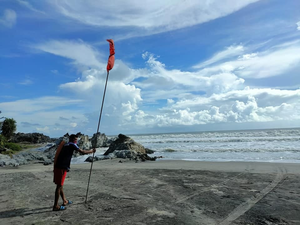Stating that the impact of climate change can be easily seen in the coastal state, environmentalists opined that the government should give priority to addressing it, or the state will suffer economically.
Goa is facing the threat of coastal erosion, losing 15 percent of its land due to the rise in the sea level and flooding, and impacting agricultural activities among others.
Environmentalist Abhijit Prabhudesai, speaking to IANS said that the climate crisis is the only issue which needs to be paid attention. “It should be the only issue for the government to tackle. As per the Goa State Action Plan for Climate Change, 15 percent of Goa's land will be lost due to flooding and other reasons. Hence it should be given priority,” he added.
According to Prabhudesai if Goa loses the land then it will also impact tourism as the beaches will go under water. “We will lose areas of tourism, on which our economy is dependent. If the economy collapses, what will we do,” he questioned.
He said that losing 15 percent of the land will be a huge loss to the coastal state. “Coastal erosion will happen due to rise in the sea level. The whole coastal area will be impacted.”
Prabhudesai stated that climate change is impacting the agricultural area and hence the government should give priority to resolve these issues by making maximum provision in the budget. “We may also suffer from lack of potable water if the ground water doesn’t recharge. There are several issues. Now the rain pattern has changed, we never know what will happen in the future. Rather than spending huge amounts on projects, the money should be spent on addressing climate change.”
He said that climate change has also impacted fruit patterns.
“Many farmers tell us that climate change has impacted cashew production and other activities. Even fishermen say that fish are moving towards other places for breeding as the climate is not suitable,” Prabhudesai said.
“Our beaches are becoming smaller due to sea erosion and the patterns of fruit and flower blossoms are changing. Even the migratory birds are coming in lesser numbers,” he said.
Abhay Naik, a farmer from South Goa, said that they are facing losses in cashew production due to climate change. “Since the last three to four years we have been witnessing a drop in our cashew production,” he informed.
According to environmentalist Rajendra Kerkar, the impact of climate change can be seen in the Western Ghats from where the Zuari and Mandovi originate.
“The flow of the rivers has become less. It is not as it was in earlier times. Due to the destruction of forests these things are happening. In the last two years, the felling of trees and fire incidents have been taking place,” Kerkar said, adding that this year there is a crisis of potable water for the people living along the Mhadei wildlife sanctuary.
Karvi also known as Strobilanthes callosus are green stubbles of foliage. These flowers vary in colour from purple blue to pink and are rich in pollen and nectar.
Kerkar said they attract many species of butterflies, birds, insects including honey bees.
He said that after it begins to bloom, the Karvi honey is relished by the sloth bears and other wild animals. “Blossoming of Karvi has been impacted due to climate change,” he stated, adding that there was no mass flowering of Karvi in recent times in the Mhadei wildlife sanctuary.
Water Resource Department Minister Subhash Shirodkar is on record saying that floods are caused in Goa due to climate change.
"In the last two to three years due to climate change, recent rain patterns and other issues, floods are taking place," Shirodkar added.
According to the Environment and Climate Change department, the National Centre for Sustainable Coastal Management (NCSCM) in the Beach Carrying Capacity Report has observed that for a coastal stretch of about 105 km, 35% of the coast is rocky terrain, 20% is stable, 27% is suffering from erosion and 17% of the coast experiences accretion.
“River mouths and port areas experience significant erosion. Pockets in the beaches of Goa are either stable or are accreting,” the report said.
According to the department, the state government has also initiated the process of implementing soft measures to control erosion.
